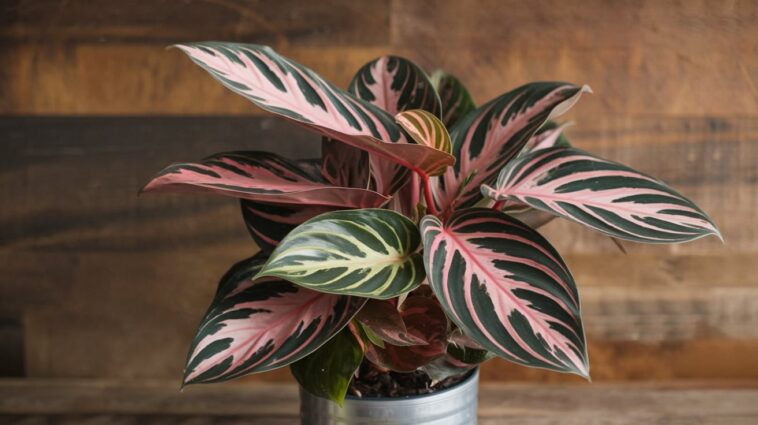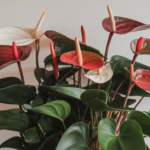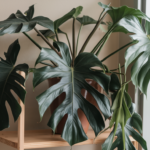I’m excited to share my knowledge on growing thriving Croton plants. These plants are a popular choice for indoor gardening. Their stunning leaves and vibrant colors make them a favorite for many.
To keep your Croton plant happy and healthy, it’s key to understand the basics of plant care. You also need to provide the right conditions for it to thrive.
As a fan of indoor gardening, I’ve learned that Croton plants need specific attention. In this article, I’ll cover the essential tips and care guide for growing healthy Croton plants. We’ll go from understanding your plant’s needs to troubleshooting common problems. We’ll focus on the best practices for indoor gardening and plant care.
Understanding Your Croton Plant
To care for your Croton plant well, knowing its background and traits is key. There are many Croton varieties, each with its own look. They come from tropical places and love warm, humid air.
Crotons can grow in different ways, from small and bushy to tall and thin. They can do well in many places because of this. Knowing how your Croton grows helps you care for it right, so it can grow big and strong.
Popular Types of Croton Plants
- Petra: Known for its vibrant, multi-colored leaves
- Gold Dust: Recognized by its golden speckles on dark green leaves
- Mammy: Characterized by its large, twisted leaves
Knowing your Croton’s type helps you learn more about its care. This includes the right amount of light, how often to water, and when to feed it. These things help your Croton stay healthy and show off its beautiful leaves.
My Experience Growing Crotons Indoors
I love growing plants indoors, and Crotons are my favorite. They do well with the right care. I’ve learned that Crotons need plenty of light. I place them near a sunny window with filtered light.
Keeping the right temperature and humidity is also key. Crotons like temperatures between 65-75°F (18-24°C) and humidity of 50-60%. I use a humidifier and keep them away from drafts. Here are some important lessons from my experience:
- Choose a well-draining potting mix to prevent root rot
- Water your Crotons carefully, allowing the soil to dry slightly between waterings
- Fertilize your Crotons regularly, using a balanced fertilizer
By following these tips, I’ve enjoyed the beauty of indoor gardening. With the right care, anyone can grow thriving Crotons indoors. It’s a rewarding experience.
| Croton Care Tip | Recommended Approach |
|---|---|
| Lighting | Filtered sunlight, 4-6 hours a day |
| Temperature | 65-75°F (18-24°C) |
| Humidity | 50-60% |
Perfect Light Conditions for Healthy Growth
Light is key for growing healthy Croton plants. It’s important to know the right light for your plant. Croton plants do well in both direct and indirect sunlight.
Finding the right mix of direct and indirect sunlight is essential. Direct sunlight is good but can burn the plant if it’s not used to it. Indirect sunlight is gentler and helps the plant grow well. Adjusting the light as the seasons change is also important.
Understanding Light Requirements
To find the best light for your Croton, consider a few things:
- Light intensity: Croton plants like bright, indirect light but can handle some direct sunlight.
- Light duration: Most Croton plants need 12-14 hours of light each day.
- Seasonal adjustments: Change the light as the seasons change to keep your plant happy.
By knowing the light needs and making seasonal changes, you can make a great home for your Croton. Watch how your plant reacts to different lights and adjust to keep it healthy.
Water and Humidity Requirements
As I care for my Croton plants, I’ve learned how key water and humidity are. It’s important to know what your plants need. For Crotons, this means the right water and humidity to thrive.
It’s vital to watch how much water your Croton gets. Too much can harm the plant, causing root rot. Too little can dry out the leaves. Finding the right balance helps your Croton stay strong and vibrant.
Here are some tips for your Croton’s water and humidity needs:
- Water your Croton when the top inch of soil feels dry to the touch
- Use a well-draining potting mix to prevent waterlogged soil
- Maintain a humid environment, ideally between 40-60% humidity levels
- Use a humidifier or group plants together to increase the surrounding humidity
By following these tips, you can give your Croton the care it needs. Remember, proper care is essential for a healthy and thriving Croton plant.
| Watering Schedule | Humidity Levels | Plant Care Tips |
|---|---|---|
| Water every 7-10 days | 40-60% | Monitor soil moisture and adjust watering schedule as needed |
| Water when top inch of soil feels dry | 50-70% | Use a humidifier to maintain optimal humidity levels |
Soil and Fertilizer Needs for Crotons
To grow healthy Croton plants, the right soil and fertilizer are key. The soil mix affects drainage and aeration. A balanced mix prevents waterlogged soil and ensures roots get enough oxygen.
Croton plants need a balanced diet for growth. A fertilizer with a balanced N-P-K ratio is best. Also, the soil’s pH should be slightly acidic to neutral. For more tips on gardening, visit productive spring garden tips.
Best Soil Mixtures for Crotons
- A mix of peat moss, perlite, and vermiculite provides good drainage and aeration
- A balanced potting mix with a pH between 6.0 and 7.0 is suitable for Croton plants
Fertilizing Schedule and pH Balance Requirements
Follow a fertilizing schedule for plant growth. Keep an eye on the soil’s pH to ensure it’s right for Croton plants.
Temperature Control and Environmental Factors
To keep my Croton plant healthy, I need to think about temperature and environment. The best temperature for a Croton is between 65-75°F (18-24°C). Extreme temperatures can harm the plant. For more tips on temperature, check out temperature control tips for variegated Croton plants.
Environmental factors like air circulation, pollution, and heat can affect my plant. To create a good environment, I do the following:
- Keep my plant away from drafts and air conditioning vents
- Use a humidifier to keep the air moist, mainly in dry winter months
- Avoid placing my plant near heating sources, like radiators or fireplaces
By paying attention to temperature and environment, my Croton plant can stay healthy and look great. Regular checks and adjustments help keep it thriving.
Pruning and Maintaining Your Croton’s Shape
Pruning is key to keeping your Croton healthy and in shape. It helps control the plant’s size and encourages bushy growth. Regular care is vital to stop overgrowth and keep your plant full and healthy.
Pruning Schedule
Prune your Croton often to keep it in shape. The best time is in spring and summer when it’s growing fast. Always use sharp, clean tools to avoid spreading diseases.
Techniques for Encouraging Bushy Growth
To get bushy growth, cut back the longest branches. This encourages new growth and keeps the plant full. Here are some tips for pruning your Croton:
- Remove any dead or damaged leaves or branches
- Cut back the longest branches to encourage new growth
- Prune the plant regularly to maintain its shape
By following these tips and keeping up with regular care, your Croton will stay healthy and look great. Watch how your plant reacts to pruning and adjust your methods as needed. This will help you achieve the shape you want and keep your plant thriving.
Common Croton Problems and Solutions
As a Croton plant owner, I’ve faced many issues like pests and diseases. It’s key to know the causes and find good solutions. Spider mites are a big problem. They can be fixed by changing humidity levels and using insecticidal soap.
Root rot is another common issue, often caused by too much water. To avoid this, make sure the soil drains well and isn’t too wet. For more info on Croton problems, check out plantaddicts.
Some common problems and their solutions include:
- Yellowing leaves: adjust the light conditions and fertilization schedule
- Leaf drop: maintain consistent moisture levels and humidity
- Pests: use insecticidal soap and neem oil to control infestations
Knowing these common problems and taking steps to prevent them can help your Croton plant stay healthy and vibrant.
Propagating Your Croton Successfully
As a Croton plant owner, I’ve found that propagating my plant is a great way to share it with friends and family or create new plants for my collection. There are several propagation methods to choose from, including stem cutting and air layering. These techniques can be used to propagate a variety of plants, and are essential skills for any plant enthusiast to master.
When it comes to plant propagation, it’s essential to understand the different methods and techniques involved. Some popular methods include stem cutting, air layering, and division. By choosing the right propagation method for your Croton plant, you can increase your chances of success and enjoy the rewards of growing new plants.
Here are some tips for propagating your Croton plant:
- Choose healthy stems for stem cutting, and make sure to cut just above a node.
- Use a well-draining potting mix to prevent waterlogged soil.
- Keep the soil consistently moist, but not waterlogged, to promote root growth.
- Consider using air layering for larger plants, as it can be a more effective method.
By following these tips and using the right propagation methods, you can successfully propagate your Croton plant and enjoy the rewards of growing new plants. Whether you’re a seasoned gardener or a beginner, plant propagation is a fun and rewarding experience that can help you share your love of plants with others.
| Propagation Method | Description |
|---|---|
| Stem Cutting | A method of propagation that involves cutting a stem from a mature plant and rooting it in soil. |
| Air Layering | A method of propagation that involves rooting a stem while it is attached to the parent plant. |
Seasonal Care Tips for Your Croton
To keep your Croton plant healthy, it’s key to give it the right seasonal care. This includes adjusting watering, humidity, and fertilization. As seasons change, your plant’s needs might shift, so you’ll need to adjust its care.
In winter, cut back on watering and add more humidity to avoid dryness. But in summer, water more often and fertilize to help it grow. Knowing these seasonal needs helps your Croton get the best care.
Here are some important seasonal care tips for your Croton:
- Change the watering schedule with the seasons
- Give extra humidity in dry winter months
- Fertilize often during the growing season
By following these tips and adjusting care as needed, your Croton will stay happy and healthy all year.
Decorating with Crotons: My Design Tips
Croton plants are amazing for decorating any room. They bring vibrant colors and unique leaf patterns. This makes any space look better. I’ll share how to use Croton plants for the best room placement and styling.
First, think about the look you want in your room. Do you want a tropical feel or a splash of color? With your vision in mind, pick the best spot for your Croton plant. It works well near windows or as a centerpiece.
Styling with Other Plants
Pairing Croton plants with other plants and decor is fun. It adds depth and interest to your room. Here are some styling tips:
- Choose plants with colors and textures that match
- Play with different heights and shapes for interest
- Add planters or vases to enhance the design
By using these tips, your Croton plant can make your room beautiful. It can add elegance or color. With the right spot and styling, your Croton will be a highlight of your home.
Conclusion: Growing a Thriving Croton Collection
As we finish our journey with Croton plants, I hope you’re excited to start your own collection. Taking care of these colorful plants can turn your home or garden into a vibrant oasis. Remember, growing a thriving Croton collection takes patience, flexibility, and a keen eye for detail.
Keep exploring the Croton care tips from this article. Try out different varieties to find the ones you love. Whether you have one Croton or many, watching them grow is incredibly rewarding.
Stay tuned for more on Croton plants and don’t hesitate to ask for help. Happy growing, and may your Croton plants fill your space with beauty and inspiration.


